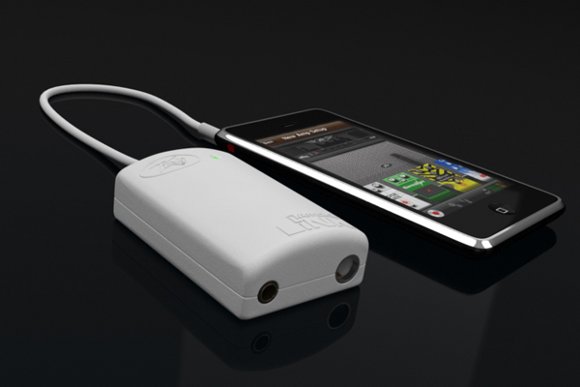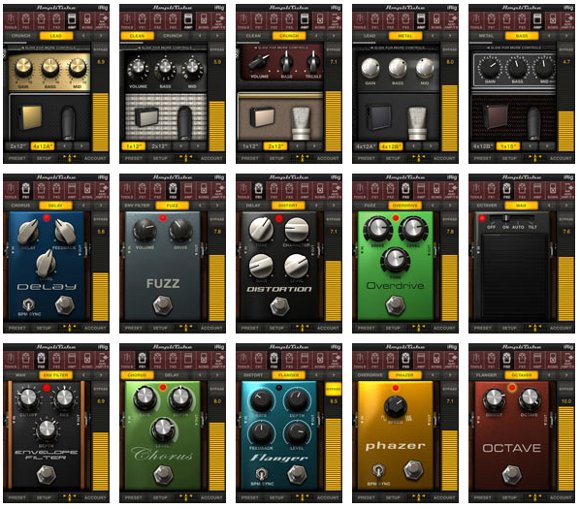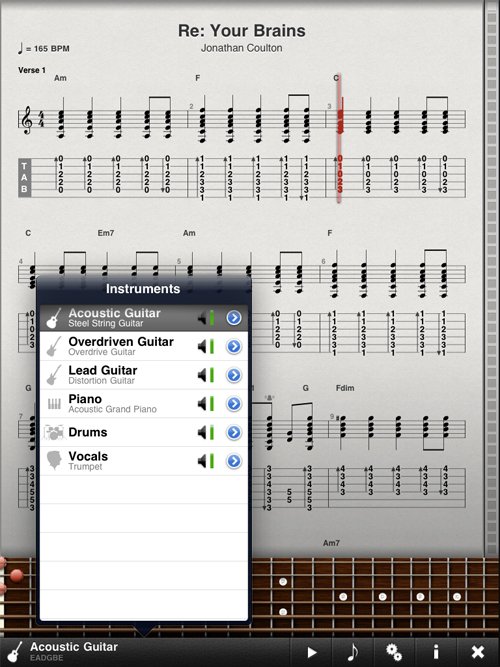
Ah, amplifiers and stompboxes. We hardly knew ye. Once exclusively the stuff of tubes, wires, cabinets, aluminum, and electronics, guitar amps and pedals have for years been available in growingly-sophisticated software models. Once the electronics of sound become software, there’s nothing stopping them from running on any computer – which now includes computers disguised as mobile phones, like the iPhone. (In fact, I expect that trend will accelerate; mobile processors are providing expanded access to native DSP functions.)
Before anyone gets to ask whether a phone is the ideal device for such a task, in the spirit of technological advancement, you’ll see simulated guitar processing from various parties.
In the past 24 hours, not one but two developers made official announcements. Agile Partners, makers of iOS’ Star6 music making software, TabToolkit tab notation tool (also on iPad), and GuitarToolkit tuner + metronome + chords and scales, partners with Peavey. IK Multimedia, makers of the industry-standby AmpliTube guitar emulation software, offer their own iPhone-specific release of AmpliTube.
AmpKit LiNK hardware [Peavey, with pre-order info]
http://ampkitapp.com [Official site]
AmpliTube iRig [IK Multimedia]
Dueling Banjos: Two Upcoming Simulations, Close Feature Sets
Here’s a quick comparison of IK’s AmpliTube and Agile/Peavey’s AmpKIT.
Hardware: Onboard audio hardware clearly won’t cut it, so both AmpliTube and AmpKIT offer specialized hardware connections. AmpKit LiNK promises to “raise the audio fidelity bar” and includes built-in cross-talk elimination for reducing feedback. iRig has its own electrical impedance adaption for line- and guitar-level input. Both cost $39.99, both have audio inputs and outputs, and most importantly, since they appear simply as audio devices, both work with any iPhone audio app. So, if IK’s software turns out to be better and Peavey’s hardware, or visa versa, you’ll be able to mix and match. Only Peavey has a skinny dude with no shirt on.
The models: AmpliTube includes 3 stompboxes, 1 amp+cabinet, 2 mics in a free app, two addition stompboxes in the US$2.99 LE, or a full 11 stompboxes, 5 amps + cabinets, and 2 mics for US$19.99. There are also a la carte models for $2.99-$4.99 each.
What’s included? IK says it will offer, in the full version: “5 amp models (clean, crunch, lead, metal, bass) with full tone and drive controls, 11 stompbox effects (delay, flanger, phaser, overdrive, distortion, filter, wah, fuzz, octaver, chorus, noise filter), 5 speaker cabinets (1×12”, 2×12”, 4×12” A & B”, 1×15) and 2 microphones (dynamic and condenser).”
AmpKit has 10 amps, 12 cabinets, 12 pedals, and 6 mics, and will also offer add-ons. Software pricing and details are currently unavailable; I’ve requested more details and will update the story when I get them.
So, both are pretty cheap; it’ll just be a matter of which software works better, and which models sound better.

Extras: AmpliTube also includes importable song playback for backing tracks (complete with real-time effects), 36 presets, and an onboard tuner and metronome, apparently in all editions – even the free one.
AmpKit also has backing tracks, custom setups with up to 12 pedals each, unlimited presets (instead of just 36), a tuner, and metronome.
Compatibility: Both work on the iPhone, iPod, and iPad.
Bottom line: These are nearly-identical products with nearly-identical feature sets. So, may the best one win.
Will people actually want it? To me, the key feature here is as a practice tool. With the iPod touch well under $200 (especially with refurbs), and no contract, guitarists get an interface that’s cheap, portable, and allows them to practice and jam anywhere. As a replacement for full-blown amp rigs, it’s probably still too limited, but that isn’t the point. If you’re recording a track or playing a live gig, it’s likely worth the extra effort to use a computer. The competition for these devices isn’t that, or even real amps; it’s the little handheld devices we’ve seen in the past for practicing, and this shouldn’t have a hard time blowing those things out of the water on price, performance, and ease of use.
Of course, the one thing you don’t get is an actual speaker. And neither of these tools has a solution for actually controlling the stomp boxes – since those would defeat the portability factor. As long as humans have ears, amps and portable amps will remain a big hit. But as practice tools, they’re likely to be big hits.
Guitar tab on iPad
Pocketable practice amps are fun, but I’d be remiss if I didn’t point to TabToolkit. It’s the only music software to be awarded an Apple Design Award this year at the World Wide Developer Conference. The feature set is pretty extraordinary, especially on the iPad: it’s the first really usable-looking, full-featured notation software on iOS. US$9.99 buys you the ability to import notation from a variety of formats — Guitar Pro, Power Tab, PDF and text tab. With the amount of text tab online, that’s a pretty big deal. It then provides tablature and standard notation views. Sure, you could just, you know, print this stuff out, and for that reason, it’s probably not going to be enough on its own to justify an iPad purchase. Likewise, you lose something in the translation from paper: it’s not quite as easy to just pick up a pencil and make a quick fingering note while you’re learning a score. But it’s nonetheless a pretty impressive way to manage access to a variety of scores, a sort of virtual fakebook of sorts, it assists people learning to play guitar with interactive fret display, and it looks like a powerful tool for play and practice.
Also, good choice of song:

Virtual backlash?
It was interesting as always to read comments last week as I reflected that phones aren’t everything in music and subsequently composed a set of haikus to try to restore perspective.
Here’s my short prediction: iPhones, iPods, and iPads are tools, and they do demonstrate how powerful mobile processors can be. At the same time, just as with computer software, musicians may find that they get a certain amount of virtual fatigue, and long for actual hardware. I think part of what will keep all of this in balance is that, for every polished and controlled device like the iPhone, there will be greater interest in DIY and music-dedicated software and devices, for everything shiny, consumer gadget with virtual software, a renewed interest in raunchy, physical hardware. And that’s a good thing.
Understood this way, a practice tool you can put in your pocket is pretty amazing. It’s not a replacement for a trusted, beloved amp. In fact, it might make you see the latter in new ways.
Analysis elsewhere:
iPhone amp modelling arms race escalates! [MusicRadar]
That seems going a bit far. I’d say this is more like when those two asteroid movies came out at the exact same time.